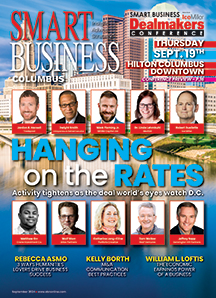There is an impending transfer of wealth that is expected to have a significant impact on Ohio.
In 2005, the Rural Policy Research Institute estimated that $1.07 trillion would change hands during the following 50 years, with $55.93 billion being transferred in Summit County alone. Ten years into that shift, an equally significant transfer has emerged — the transfer of leadership and philanthropic legacy.
Smart Business spoke with Thomas Venarge, president of APV Engineered Coatings, to discuss how he and his father conducted a successful leadership transfer that involved both their family business and philanthropy.
What was essential to the successful transfer of leadership from your father to you?
Part of our formula for a successful transfer has been time and patience. I’ve been working in the company for 25 years, more than half my life, and have been taught how the company operates by my father, who still remains active in the business.
Another aspect is mutual trust and respect.
My father and I both trust each other. We may not always agree, but we respect each other and know that when it comes down to it the goal is always the success of our business.
The last component is preparation and constant communication. He and I have talked and prepared for the transition for many years.
It’s important to start planning early, stay in the game and work on your plan.
Many business executives haven’t thought about how their legacy will endure. It’s important to think about that and visualize what your company might look like 10 to 20 years down the road. Part of that is considering what happens when you’re no longer involved in the business day to day.
How does that planning extend your family’s philanthropic legacy?
Our primary concern is that the family’s philanthropic legacy continues and that it gets ingrained in me and my children and my sister’s children.
Our family’s legacy is something we’re proud of and we want to protect it. We want it to continue, thrive and grow, and become a part of who we are as individuals and as businesspeople.
How is your family working to ensure its philanthropic efforts will continue?
It’s a constant work in progress.
What we’re doing now to help ensure our success through leadership and charity is getting my children and my sister’s children involved so early that it’s practically part of their DNA.
Two of my three daughters, all of whom are not yet teenagers, have learned about philanthropy and have worked successfully to provide real money for real people for real problems before they learned to ride a bicycle. It’s never too early to get started.
Having a donor-advised fund at our local community foundation has made philanthropy very easy for me and fun for the girls.
The community foundation outlines funding opportunities in our areas of interest and provides us with all the research. They comb their database for programs that may appeal to my daughters because they affect children their age.
The girls get a warm feeling from helping kids in general, but it’s much more special when they’re helping kids they know, who ride on their school bus and who are in their classrooms.
Much like he did with the business, my father also uses the fund to show us the causes that are important to him, preparing us for when it’s our time to manage the donor-advised fund.
What advice would you offer other families that are preparing for similar transfers?
Many families see their business and charitable legacies falter because of a difference of opinion. The best advice I can give is to communicate constantly.
My father and I share everything: good news, bad news and the worst news. I can’t be afraid to tell him anything. The lines of communication must be open and used all the time to talk about everything and anything, regardless of how tough the subject is.
Some conversations aren’t fun, but they are critical. He and I may disagree on something, but at the end the of the day, I’m his son and he loves me. I’m not worried that I’ll be disowned or fired. I can tell him whatever, whenever — and that’s critical. ●
Insights Philanthropy is brought to you by Akron Community Foundation

